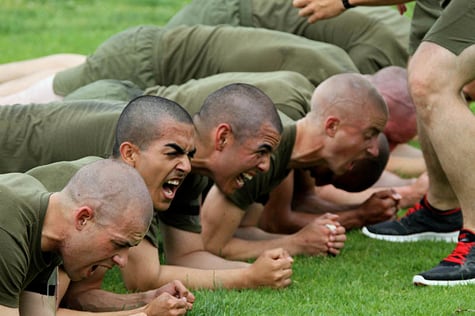Marines have complained for ages that the crunches portion on the Physical Fitness Test, or PFT, is too easy, administratively hard to judge and easy to cheat on.
Now the Corps is looking at planks as an alternative.
In a December briefing for the Defense Advisory Committee on Women in the Services, the Corps said its Force Fitness Division, led by former Marine athlete of the year Col. Stephen Armes, was conducting a study on the use of planks as an alternative to crunches.
“The Marine Corps Force Fitness Division is currently testing and analyzing the use of planking as a possible measure of abdominal strength for the annual Physical Fitness Testing," Marine Corps Training and Education Command said in a statement. “Their testing remains ongoing.”
A plank is performed by holding the body in a tight formation, generally in a pushup-like position, and maintaining that form for a period of time. It is considered an isometric core exercise, as unlike crunches a plank does not involve contraction of the muscles during the workout.
Because the plank does not involve movement, there’s the possibility it could lead to fewer exercise related injuries during the PFT. The crunch portion of the PFT is often very sloppy as Marines rush to bang out over 100 crunches with poor form as they try to max their overall fitness scores.
“As a coach, I have my athletes do some ab variation at the end of every workout, but never does it include a ‘Marine Corps’ style situp,” said former Marine Sgt. Timminy Moore. “Those are not only not a good indicator of abdominal fitness, but it’s not good for lumbar or cervical spine.”
Since leaving the Corps in 2012, Moore has actively competed in powerlifting and CrossFit and has coached both sports for several years.
Brian Schilling, a professor of kinesiology and nutrition sciences at the University of Las Vegas, Nevada, said the Corps was wise to look at the plank as an alternative to crunches.
“For the most part, the muscles of the torso are ‘anti-motion;’ they work to stabilize the torso. This makes the plank a good representation of the real demands placed on the torso muscles,” Schilling said.
Schilling added that a 2012 study he co-authored in Military Medicine showed that the plank is “reliable,” and that over half of Navy sailors in the study wanted the plank to be part of the Navy fitness test.
Marines in a variety of fields say they would welcome the potential change, with some describing planks as a better core workout and a test easier for Marine leaders to administer.
One Marine Raider told Marine Corps Times that the plank was just an all-around better core workout, and from an administrative standpoint it is easier to judge proper form and harder to cheat on.
”It’s easier for me to look down a line and see everyone’s stomach off the ground than it is for me to count everyone’s crunches. So administratively it’s easier,” the Marine Raider said.
Male and female Marines between the ages of 21–40 have to knock out between 105–115 crunches depending on age and gender to maximize their score.
But it’s hard for scorers to accurately judge proper crunch form and the exercise is easily susceptible to cheating.
“For decades, people have just lied to help out their friends. With only a few proctors walking around to ensure the crunches were executed properly, it left a lot of room for cheating,” a recon Marine said.
Moore echoed those sentiments. “There’s so many ways to ‘game’ the ‘Marine situp’ to cheat the movement while still remaining in standards,” she said. “Planks are a good test of overall core stability; they test not just the main ab muscles, but also lats, rear delts, rhomboids, low back, quads, glutes, obliques; everything equally.”
Not everyone is sold on the idea that the plank will remove subjectivity from the test. It could be just as difficult to judge, leading to varying unfair standards across the Corps.
“Since there are some challenges with what is considered good form for both exercises in any case, so there will likely be no perfectly objective test,” Schilling said.
The Corps recently has flooded the force with nearly 600 Force Fitness Instructors, or FFIs, who have been charged with enforcing strict standards on the fitness tests.
“There was a lot of slop out there,” Armes said. Now there’s an FFI at the unit saying, “nope, that pullup doesn’t count … that crunch is not executed correctly.”
If the Corps decides to move to planks, those FFIs will help enforce proper form and standard with the new test.
Shawn Snow is the senior reporter for Marine Corps Times and a Marine Corps veteran.




